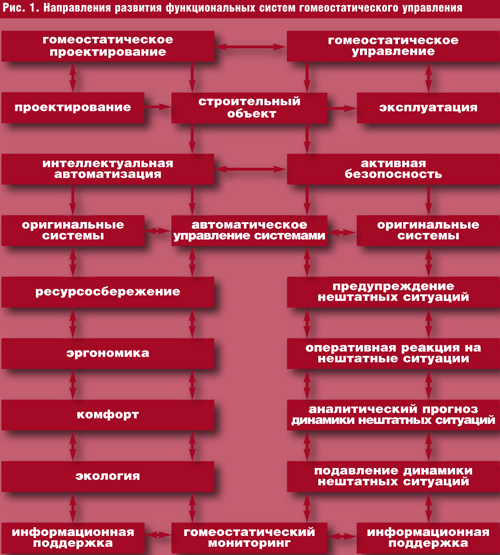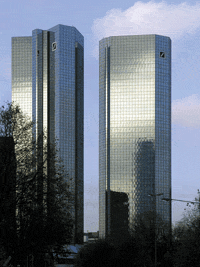Author: Volkov A.A.Doctor of Engineering Sciences, Professor, Dean of the Faculty of ISTAS MGSU
This article continues a series of publications presenting the fundamentals of the promising science of designing “intelligent” buildings, directly aimed at eliminating the existing methodological gap between practice and theory in creating automation systems for buildings and structures at all levels (see Bulletin “AZ”, No. 5/2006; No. 6/2007).
The original paradigm of the homeostat of buildings and structures is considered
In general, the methodology of functional management of buildings and structures involves an analysis of the theory and practice of constructing ultra- and multi-stable systems for managing a construction project, based on the assumptions (essentially scientific and technical hypotheses) of the existence of an objectively real possibility:
1) managing the processes of changing the actual functional and/or technical characteristics of a building (structure) and/or its elements (in this case, managing the building (structure) itself is interpreted as managing the processes of changing such characteristics);
2) construction of a strategy and scenarios for such control for an object with a known set of functional and technical characteristics in terms of existing or original formal languages (in this case, the target control function is compensation and/or suppression of the influence of disturbances of any nature and intensity on the stable state of the control object);
3) creation of engineering and technical systems that practically implement the process of controlling a building (structure) in the described sense, taking into account the established limitations and assumptions.
Let us dwell on the essence of the concept of functional control systems for buildings and structures, as the basis of the homeostatic methodology of construction projects, and the analysis of the theoretical foundations of designing functional systems for homeostatic control of buildings and structures.
Analysis of the prospects for using the principles of the theory of functional systems (P.K. Anokhin) and construction systems engineering (A.A. Gusakov) to solve problems of managing buildings and structures in the sense described above allows us to talk about the possibility of creating a methodology for a homeostat of construction objects precisely as a functional system.
A homeostat (from the Greek homoios — similar, identical and statos — standing, motionless) is a self-organizing system that models the ability of living organisms to maintain certain values within physiologically acceptable limits. The English scientist W.R. Ashby, the inventor of the homeostat, designed its simplest form in 1948 in the form of a device consisting of four magnetic systems with cross-feedback.
The concept of «homeostat» is a systemic embodiment of the phenomenon of homeostasis (from the Greek homoios — similar, identical and stasis — state, immobility), in physiology — the relative dynamic constancy of the composition and properties of the internal environment and the stability of the main physiological functions of living organisms. The term «homeostasis» was proposed by the American physiologist W. Cannon in 1929.
However, the idea of the constancy of the internal environment was formulated back in 1878 by the French scientist K. Bernard as a result of complex coordination and regulatory relationships carried out both in the whole organism and at the organ, cellular and molecular levels.
It is necessary to note the fact of existence of a number of works of domestic and foreign authors, created at different times, in which the concept of «homeostat» is used in one way or another to solve theoretical and, to a much lesser extent, practical problems in various fields of science and technology. Individual studies, which do not contain, however, similar formulations of management problems and features of a complex methodology, touch upon the issues of using homeostat principles in construction.
The nature of the target function of managing buildings and structures in the context of the study involves defining the homeostat of construction objects as a functional system aimed at limiting and suppressing the impact of disturbances of any nature and intensity on the stable state of the construction object. The obvious goal of such an approach to building a methodology is the objective need to “teach” buildings and structures an adequate response to negative environmental impacts and internal disturbances by means of original information technology systems — functional systems of homeostatic management of a construction object.
Homeostatic control is a complex, including operational, adaptive control of objects, processes, systems and their elements, functionally oriented towards limiting and suppressing the influence of disturbances of any nature and intensity on the stable state of the control object in order to preserve it.
The effectiveness of real functional systems of homeostatic control of a construction project depends, first of all, on how much the building or structure is “controllable” in principle, how much the original technical, technological and other design solutions correspond to the principles of homeostatic control, i.e. a comprehensive solution to homeostatic control problems implies mandatory design of a construction project at a homeostatic level.
Homeostatic design is a system engineering design of objects, processes, systems and their elements, conceptually oriented towards the adaptation of original technical, technological and other solutions to the functions of homeostatic control. It is important to note that the formation of the structure and composition of systems and scenarios of homeostatic control should occur at the stage of homeostatic design of a construction project.
The use of homeostatic methodology in the design, construction and operation of buildings and structures is a complex system engineering problem, the solution of which opens up promising areas for the development of systems within the framework of the proposed concept, the main ones of which are a qualitatively new level of intelligent automation and active safety of construction projects (Fig. 1).

Systems engineering analysis of the theory and practice of solving such problems allows us to formulate the principles of designing functional systems of homeostatic control of buildings and structures, the main ones being the following:
1. The principle of homeostatic design (homeostatic design of a construction project).
2. The principle of modeling (formation and analysis of strategies and management scenarios, structure and composition of functional systems of homeostatic management at the stage of homeostatic design of buildings and structures).
3. The principle of optimization of design solutions (optimization of original technical, technological and other design solutions according to the criterion of minimizing the number of possible management scenarios for a construction site with a known set of functional and technical characteristics).
4. The principle of system design (analysis and design of functional systems of homeostatic control within the framework of a concept that systematically unites all areas of intelligent automation and active security of buildings and structures).
5. The principle of open information systems (design of information components of functional systems of homeostatic control of buildings and structures within the framework of the concept of open (including distributed) systems).
Guided by the proposed methodological concept, the main tasks of its practical implementation are projected onto the plane of creating a complex of analytical and information environment for homeostatic design and management processes.
Analytical support of functional homeostatic control systems is a set of systemically integrated methodological, methodical, mathematical and other solutions and tools that allow for the optimal and full implementation of homeostatic design and control functions based on the presentation of buildings and structures as objects of target management. This implies both the widespread use of existing calculation methods and computational algorithms, and the development and implementation of fundamentally new approaches to solving process control problems within the life cycle of buildings and structures, the sufficient diversity and progress in the creation of which are currently objective evidence of the possibility of analyzing, modeling and effectively solving homeostatic design and control problems for construction projects, systematically combining modern and promising areas of theoretical and practical research in the designated area. Thus, the modern development of construction systems engineering (A.A. Gusakov) allows us to talk about the prospects of the declared principles with scientific achievements in organizational and anthropotechnical reliability (V.O. Chulkov) at the level of infographic modeling of the «man — technology — environment» systems.
The information environment of functional homeostatic control systems is a complex of information technologies and software at all levels, aimed at supporting homeostatic design and control processes based on the use of open information systems technologies. The basis for designing information components of functional homeostatic control systems is the adaptation and use of standard solutions in the field of information support for construction design, production and control processes. The class of original tasks is made up of tasks that do not imply standard formulation and solutions.
The analysis conducted allows us to talk about the possibility and prospects for developing a complex of information environments for functional homeostatic control systems based on modern information technologies and system design methods, united by the proposed methodological concept.
Read the continuation in the next issue.
AZ Bulletin No. 9 2007
